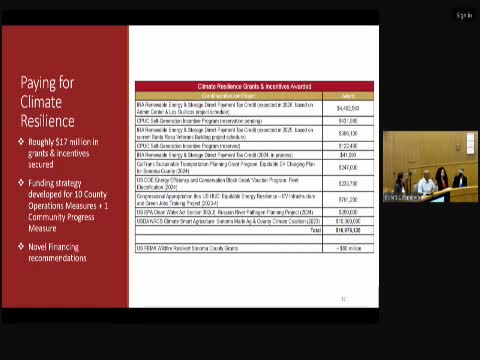Sonoma County unveils ambitious climate resilience funding strategy
August 13, 2024 | Sonoma County, California
This article was created by AI summarizing key points discussed. AI makes mistakes, so for full details and context, please refer to the video of the full meeting. Please report any errors so we can fix them. Report an error »

In a recent government meeting, officials outlined a comprehensive funding strategy aimed at enhancing climate resilience across ten county operations and one community progress measure over the next three years. The strategy, developed with the assistance of consultants, identifies eleven key measures, including fleet electrification, land sequestration, and sea level rise planning, which are critical for advancing the county's climate goals.
The meeting highlighted various funding opportunities available to support these initiatives. In the first year alone, eleven funding sources have been identified, with an additional 15 in the second year and four anticipated in the third year. A significant potential funding source mentioned is the California climate resilience bond, which, if passed, could provide approximately $55 billion for climate planning and adaptation efforts.
Officials also discussed the importance of collaboration in securing grants. A notable example was the Green Corridors grant, which, despite being paused due to state budget constraints, was recommended for consideration by the U.S. Environmental Protection Agency, allowing the county to pursue alternative funding avenues.
The meeting further explored innovative financing strategies, including the establishment of a working lands carbon mitigation bank and a residential retrofit offset reverse auction program. These initiatives aim to fund carbon sequestration and support low-income housing retrofits for electrification and efficiency, although they are still in the planning stages.
No immediate decisions were requested from the board during this session, as the focus was on providing information to facilitate future discussions regarding the climate resilience comprehensive action plan and potential staffing changes within the climate action and resiliency division. The county remains committed to advancing its climate initiatives and is optimistic about the collaborative efforts ahead.
The meeting highlighted various funding opportunities available to support these initiatives. In the first year alone, eleven funding sources have been identified, with an additional 15 in the second year and four anticipated in the third year. A significant potential funding source mentioned is the California climate resilience bond, which, if passed, could provide approximately $55 billion for climate planning and adaptation efforts.
Officials also discussed the importance of collaboration in securing grants. A notable example was the Green Corridors grant, which, despite being paused due to state budget constraints, was recommended for consideration by the U.S. Environmental Protection Agency, allowing the county to pursue alternative funding avenues.
The meeting further explored innovative financing strategies, including the establishment of a working lands carbon mitigation bank and a residential retrofit offset reverse auction program. These initiatives aim to fund carbon sequestration and support low-income housing retrofits for electrification and efficiency, although they are still in the planning stages.
No immediate decisions were requested from the board during this session, as the focus was on providing information to facilitate future discussions regarding the climate resilience comprehensive action plan and potential staffing changes within the climate action and resiliency division. The county remains committed to advancing its climate initiatives and is optimistic about the collaborative efforts ahead.
View full meeting
This article is based on a recent meeting—watch the full video and explore the complete transcript for deeper insights into the discussion.
View full meeting
